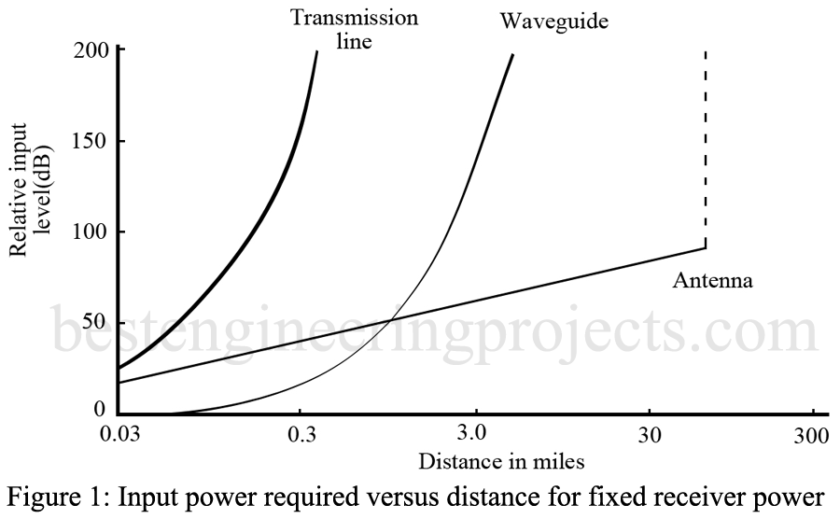In the article “Comparison of Transmission Systems”, we will comparison transmission lines, waveguides, and antenna. The mode of energy transmission chosen for a given application would normally depend on the following factors:
- initial cost and long-term maintenance
- frequency band to be used and its information-carrying capacity
- selectivity or privacy offered
- reliability and noise characteristics
- the power level and efficiency.
Naturally, anyone mode of energy transmission will have only some of the desirable features. It, therefore, becomes a matter of sound technical judgment to choose the mode of energy transmission best suited for a particular application.
Comparison of Transmission Systems
Transmission lines and antennas are the more commonly known means of high-frequency energy transmission, but waveguides and fiber optics also play an important role. The following examples show that each method of transmission has its proper place.
It is desired to transmit a 1-GHz signal between two points 30 miles apart. If the received energy in each case were chosen to be 1 nW (109 W), then for comparison it would be found that for reasonably typical installations, the required transmitted power would be on the order of
- Transmission lines: 101500 nW (15,000-dB loss)
- Waveguides: 10150 nW (1500-dB loss)
- Antennas: 100 mW (80-dB loss)
Clearly, the transmission of energy without any electrical conductors (antennas) will be found to excel the efficiency of waveguides and transmission lines by many orders of magnitude. As a practical consequence of these results, microwave antenna relay links at about 30 miles intervals are used for cross-country transmission of telephone and television services.
If the transmission path length of the preceding example were shortened by a factor of 100:1 to a distance of 1500 ft, the comparison would become
- Transmission lines: 1 MW (150-dB loss)
- Waveguides: 30 nW (15-dB loss)
- Antennas: 10 uW (40-dB loss)
Quite clearly the waveguide now surpasses either the transmission line or antenna for efficiency of energy transfer.
A comparison of the energy input required versus distance to obtain a received power of 1 nW for these three modes of energy transmission is shown in Figure 1. The frequency is 1 GHz, and the results are expressed on a decibel scale with a 0-dB reference at the required receiver power level of 1 nW. The dashed section of the antenna curve, somewhat beyond 30 mi, indicates that the attenuation becomes severe beyond the line-of-sight distance, which is typically 50 miles.
One final comparison, and then a specific look at waveguides. Transmission of energy down to zero frequency is practical with transmission lines, but waveguides, antennas, and fiber optics inherently have a practical low-frequency limit. In the case of antennas, this limit is about 100 kHz, and for waveguides, it is about 300 MHz. Fiber Optic transmissions take place at the frequency of light, or greater than 1014 Hz! Theoretically, the antennas and waveguides could be made to work at arbitrarily low frequencies, but the physical sizes required would become excessively large. However, with the low gravity and lack of atmosphere on the moon, it may be feasible to have an antenna 10 miles high and 100 miles long for frequencies as low as a few hundred cycles per second. As an indication of the sizes involved, it may be noted that for either waveguides or antennas the important dimension is normally one-half wavelength. Thus, a waveguide for a 300MHz signal would be about the size of a roadway drainage culvert, and an antenna for 300 MHz would be about ft long.
